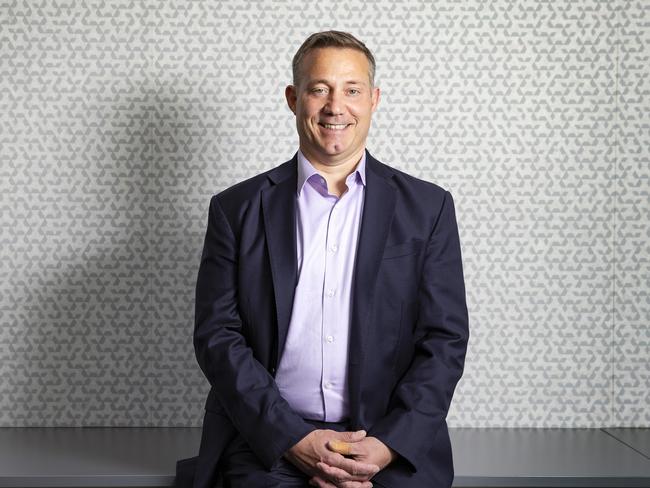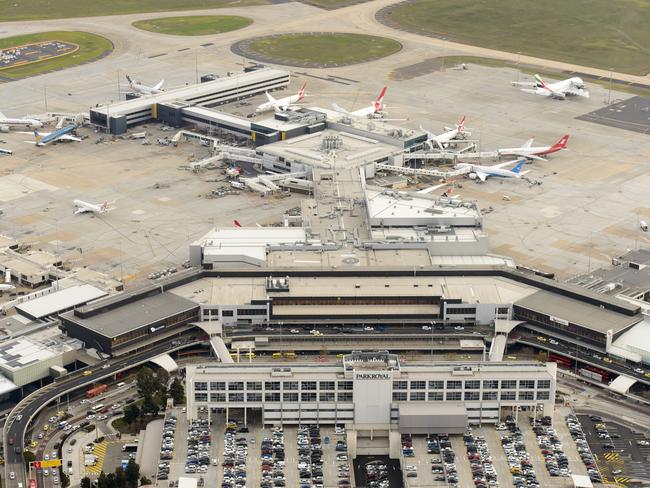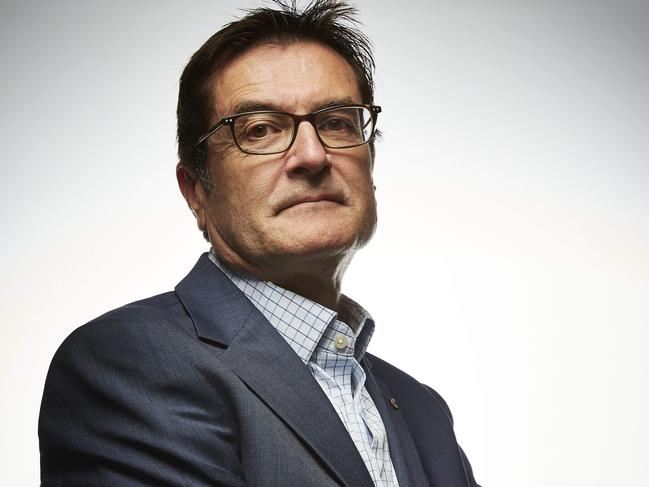Meet the American at the helm of an Aussie funds management titan
You may not know it, but there’s a good chance your retirement nest egg is wrapped up in it. Meet the Aussie funds management titan with more than $130 billion in the kitty — and the US-born executive calling the plays on some of its biggest deals.
Business
Don't miss out on the headlines from Business. Followed categories will be added to My News.
You get a hearty laugh when you ask Kyle Mangini about his nickname from his American college football days.
For context, the Connecticut native’s brother, Eric, is a former head coach of NFL team the New York Jets, where he was dubbed “The Mangenius” — a moniker that earned him a cameo on The Sopranos.
Mangini acknowledges he never had such a flattering label.
“I do not … when I played football I was big but I was slow so they did call me ‘Lead Legs’ for a while,” he tells Business Daily.
“Mangenius is a better nickname.”

Mangini’s football days — he was a linebacker for the Bulkeley High School Bulldogs and then Wesleyan University Cardinals, both of which are in Connecticut — may not have earned him a nickname he wants to remember.
But they did teach him a lot about character and imparted life lessons he now puts into use at Australia’s IFM Investors, where he is global head of its core infrastructure division.
“Every single position matters,” Mangini says.
“There’s 11 people on each team doing very, very different things. And if even one of those positions is unbalanced, the entire game changes.
“There is a great expression (in gridiron) which is you want the players that play for the name on the front of the shirt, not the back of the shirt.
“You really want to bring in individuals who are dedicated to driving an outcome.”
PLANES, TRAINS AND AUTOMOBILES
Originally called Industry Funds Management, Melbourne-based IFM is owned by 27 industry superannuation funds including the nation’s biggest, AustralianSuper.
As of May, it had $134 billion in assets under management. Of that, about $4 in every $10 is invested in infrastructure — from airports to tollways and electricity networks.
The infrastructure division is its biggest, accounting for $55.7 billion of its funds. IFM also provides loans for major projects and invests in shares.
Its super-fund owners are among clients of the fund manager, which invests cash on their behalf.
In the case of AustralianSuper, IFM manages about 20 per cent of its assets.
Mangini joined the fund manager in 2007 after time with investment banks Credit Suisse and UBS.
He started with a staff of 13 and now runs a team of 80.
So how has a relatively young company of less than 30 years, operating out of Melbourne and Sydney, come to throw such a heavy punch in the red hot global infrastructure market?
Mangini attributes much of the success to an early recognition that road, rail, ports, airports and power companies — assets underpinning cities and economies worldwide — were worth investing in.
Australia has also led the world in privatising assets, a drive that came as many super funds were growing strongly and looking for avenues to park their cash.

“This meant that not only was there deal flow, but there was an awareness of that asset class among fast-growing super funds,” Mangini says.
“In Australia, infrastructure is viewed very much as an asset class, whereas in a lot of other parts of the world — the US for instance — it falls into a lot of other categories. It is nowhere near as well understood.”
Among recent IFM deals, in March last year it paid $1.6 billion for a 49 per stake in Spanish water group FCC Aqualia, one of Europe’s biggest water companies.
Two months ago it struck a deal worth more than $US10 billion to buy US oil pipeline operator Buckeye Partners. It will take the listed company private, assuming the deal is approved by regulators.
Not that it has all been smooth sailing.
Late last year the Australian Competition and Consumer Commission launched proceedings in the Federal Court against the operator of Port Botany and Port Kembla — both owned by, among others, IFM and AustralianSuper.
The watchdog alleged agreements with the New South Wales government included a provision that had an anti-competitive purpose or effect. Mangini can’t comment but the ports are expected to fight the matter.
BUY, DON’T SELL
Mangini says a crucial part of the IFM philosophy is to buy assets it will likely never sell.
“We are always thinking in terms of owning assets for the very long term,” he says.
“When we make our investment case to our investment committee, it doesn’t include an exit strategy — we want to hold it forever.”
As part of that approach, IFM frequently buys in as a partner, rather than buying the entire business, Mangini says.
“When people sell all of an asset, all they care about is price,” he says.
“When they are selling part of an asset, they really care very much about who they are sitting next to. We have been extremely active in buying in situations where partners are selling down and not selling out.”
Mangini says that while there has long been a substantial amount of Australian capital ready to invest in infrastructure, more and more global funds are seeking out the asset class.
“There is a much more active pool of capital that is interested in investing, which creates a tremendous opportunity for governments and politicians to tap that capital,” he says.
But the added interest can bring risks.
“There have been some investors who have come into the market relatively recently who don’t fully understand the risks associated with the asset class and think of it as very low risk — of almost being bond like,” he says.

“In some cases they are mispricing that risk and overpaying for assets. There are a number of examples where very good assets became bad deals simply because there was a period of too much debt.”
Someone’s pain can, however, be IFM’s gain.
Assets that fall into receivership do often “present really compelling opportunities”, Mangini says.
The Indiana Toll Road, a tolled motorway that runs 251km from northern Indiana to the Illinois state border in the US, is a perfect example.
In 2006, IFM bid but lost to an aggressive $US3.85 billion debt-heavy deal put together by a consortium which included Australian investment bank Macquarie.
The tollway operator fell into bankruptcy in 2014 after interstate trucking travel declined in the wake of the global financial crisis.
That gave IFM an opportunity to move in.
“If you put so much debt on an asset, you are relying on growth to cover that debt and if the growth doesn’t eventuate, you lose the asset,” Mangini says.
The episode also taught him a lesson in building goodwill over the long term.
“When we took over at the Indiana toll roads, we worked out we could completely resurface that road and upgrade all the bridges and bring forward all that capital expenditure, which we did,” Mangini says.
“That saves us money over the long term, but from a political perspective it is exceptional because the government is able to announce the entire road is upgraded at zero cost to the taxpayers — that’s a great outcome.”
CHANGING OF THE GUARD
IFM marked the start of 2019 with its first new chair in 16 years.
Garry Weaven stepped down on January 1, replaced by former federal Labor minister and Australian Council of Trade Unions secretary Greg Combet.
Combet has been on the IFM board for four years.
“I’ve had a chance to work with Greg on a couple of transactions,” Mangini says.
“Greg — like Gary — is at the end of the day extremely commercial and very, very sensible and you can’t overstate the value of those adjectives.”
Mangini says there is an increasing role for IFM in proposing projects, rather than snapping up existing infrastructure.
He points to its proposal for a $15 billion rail link from Melbourne’s CBD to Melbourne Airport.
It is being considered by the Victorian government.
Trains from Southern Cross Station to the airport would run every 10 minutes and trips would take no more than 20 minutes under the proposal.
“People have been talking about a Melbourne Airport rail link for decades,” Mangini says.
“When we saw the commitment from federal and state governments to this project, it became apparent that long-term patience and community-aligned capital could provide a vital missing piece to (help in) finally bringing this project to life.”

He also notes US president Donald Trump’s long-touted plan to upgrade railways, roads and bridges there.
Momentum around Mr Trump’s proposed $US1.5 trillion ($2 trillion) public works program has stalled since the midterm elections last year, but Mangini maintains hope.
“I grew up in America and I would be so pleased if we contributed to refreshing a lot of those assets that were built in the 1950s and are in a dire need of an upgrade,” he says.
“I would love to be part of the solution. It is just extremely challenging politically — it is all local.” Not that impasses around infrastructure are unique to the US.
MORE: HOW MUCH SUPER SHOULD YOU HAVE
HOW TO COPE WITH FALLING RETURNS
“Everywhere in the world, if politicians make a decision and it doesn’t go well, they are going to get punished,” Mangini says.
“If they don’t make a decision, nobody really notices.
“So there is this natural tendency to not want to rock the boat.”
While Australia in many ways still leads the world in how it thinks about renewing infrastructure, Mangini says there is much work to do, particularly around long-term planning.
“A lot of the work now is retrofitting — the population has grown so much and the traffic has gotten so bad we’ve got to do something to solve that problem,” he says.
“The real opportunity is not to retrofit but to think forward and to build the right infrastructure and to grow into it.”


